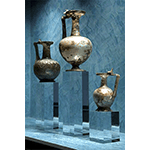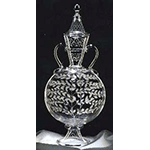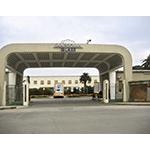Glassware in Tuscany

Glass, known since the most remote ages, was subjected to increasingly refined processing over the course of time. Since the 13th century Tuscany had played a leading role in Italian and European glassware production. Starting from Medicean times, the Tuscan master glassmakers specialised in producing not only refined artistic glassware, but also sophisticated instruments for pharmaceutical use and scientific experiments.
Technique and art of glassmaking from the origins to modern times
Glass is a solid amorphous material obtained through the fusion of a complex mixture of elements that, utilised in varying proportions, confer different characteristics on the final product. From analyses conducted on specimens from pre-industrial times it has emerged that this mixture consisted mainly of silica (vitrifying), to which was added alkaline oxides, such as soda and potassium, to lower the melting point (and for this reason called flux), calcium carbonate to augment the chemical strength of the final product (stabiliser) and a decolourant. In addition to these and other minor components, the mixture could also contain fragments of old vitreous objects previously ground to powder, which lowered the melting point of the vitreous mass still further. This need, particularly urgently felt in the pre-industrial age, due to the difficulty of obtaining very high temperatures with the old wood-burning furnaces, was also satisfied, for glass with a soda base, by carrying out a procedure in two stages, consisting first of preparing a semifinished product called frit, obtainable at relatively low temperatures (700°C-800°C), and then of melting it only in the second stage. This process, described also by Pliny the Elder in his Naturalis Historia, was carried out in furnaces with two or more superimposed compartments, usually circular in shape, according to a typology that remained basically unchanged throughout the pre-industrial period, as demonstrated by archaeological findings and by the analysis of iconographic documents of the time.

The beginning of glassware production in Tuscany
At the current stage of investigation, the only certain evidence of a glassware production in Roman times seems to consist of the objects found under Piazza della Signoria in Florence, which have led to the identification of glassware probably dating from the late 4th to the 5th century A.D.
Although not of local provenance, interesting for a historical panorama of glass production is the collection of the Museo del Vetro in the Castle of Poggio alle Mura near Montalcino which, in addition to illustrating the evolution of techniques and forms from the 3rd millennium B.C. to our own day, displays a rich collection of Roman glassware.
Archaeological and figurative testimony from the 13th to the 15th century
Starting from the 13th century, the evidence of glassware production in Tuscany becomes more common. Alongside numerous fragments of glass tableware, pertinent to both objects of everyday use and precious products reserved to the upper classes, the systematic excavations conducted starting from the second half of the 20th century have allowed us to identify, among the numerous centres of production in Tuscany, some centres of excellence located in the Valdelsa. In the districts of Montaione and Gambassi Terme, in particular, production facilities from medieval times have been brought to light, such as the glassware workshop at Germagnana, documented by the local permanent exhibition.
Among the forms most commonly found for the period in question are cylindrical truncated-cone shaped glasses with smooth walls, and glasses moulded with geometric motifs in relief, whose decoration, long thought to be a Tuscan prerogative, has been found to be rather common in the Italian and European sphere. Another well-documented typology consists of narrow-necked bottles with globular body and, to a lesser degree, of pharmaceutical phials. Rarer, instead, are goblets, which became common at a later age, and tableware consisting of cups and pitchers, probably the prerogative of the upper classes. Glasses and glass bottles are frequently depicted in the paintings of the time, especially those illustrating Biblical stories (The Last Supper, The Marriage at Canna, etc.), while among the glass containers linked to medical practice, such as the 'matula' used for urinalysis, may be cited three interesting objects: the fourteenth-century formella from Giotto's Bell Tower portraying a medieval 'outpatients' clinic', now in the Museo dell'Opera di Santa Maria del Fiore in Florence, the fifteenth-century fresco Care and Government of the Sick by Domenico di Bartolo in the Hospital of Santa Maria della Scala in Siena, and the coeval painting by Fra Angelico The Recovery of Deacon Giustiniano, in the Museo di San Marco in Florence. Lastly, the productions of this period include, it must be remembered, not only ordinary window panes, but also the stained-glass windows of Tuscan churches, in particular the fifteenth-century cycles found in the Cathedral of Pisa and the Duomo of Florence .
-
 Cathedral of Santa Maria del Fiore
Cathedral of Santa Maria del Fiore -
 Complesso Museale di Santa Maria della Scala [Santa Maria della Scala Museum Complex]
Complesso Museale di Santa Maria della Scala [Santa Maria della Scala Museum Complex] -
 Mostra permanente 'La produzione vetraria a Gambassi' ['Glass Production in Gambassi' Permanent Exhibition]
Mostra permanente 'La produzione vetraria a Gambassi' ['Glass Production in Gambassi' Permanent Exhibition] -
 Museo dell'Opera di Santa Maria del Fiore di Firenze [Museo dell'Opera di Santa Maria del Fiore]
Museo dell'Opera di Santa Maria del Fiore di Firenze [Museo dell'Opera di Santa Maria del Fiore] -
 Museo di San Marco [Museum of San Marco]
Museo di San Marco [Museum of San Marco]
Glassware production under the Medici dynasty
Already by the second half of the 15th century, among the Venetian production, which had flourished on the European level thanks mainly to the invention and perfecting of crystal glass, and the Florentine production, a difference in taste began to emerge, always linked, in the case of Tuscany, to the propaganda program of the reigning house. While the high-quality production of much of the Florentine 16th century was still the work of Venetian glassmakers who had moved to Florence, between the end of the 16th century and the beginning of the 17th, production in the Florentine sphere became emancipated from the Murano models to acquire a character of its own. Under Francis I, Ferdinand I and Cosimo II, the workshops were reorganised and new foundries were opened, such as the one in the Casino Mediceo of San Marco and the one opened in the Boboli Gardens in Florence. The new glassware forms, of typically Mannerist taste, in addition to finding a place in the treatises and repertories of the age, the most important of which was the Arte vetraria [Art of glassmaking] by Antonio Neri, were admirably depicted in coeval paintings, such as the frescos of Alessandro Allori in the Medicean villa of Poggio a Caiano. The objects depicted were stemmed goblets, cone-shaped glasses, vases with lids, splendid dishes for display and elaborate centrepieces (created to amaze and amuse the diners), of which an important collection is to be found in the Museo di Storia della Scienza in Florence.
Starting from the 17th century, the glassware linked to scientific experimentation also assumed particular importance, such as that utilised by the Accademia del Cimento, which includes thermometers, densimeters and ampules of various kinds, these too conserved at the Florence Museum of the History of Science. Deserving of separate mention is the optical glassware, whose perfection brought about improvement in lenses for eyeglasses, depicted rather often in paintings from the 17th century, as exemplified by the painting of Giovanni Bilivert in the Museo di San Marco in Florence. It was just during these years, moreover, that Galileo, thanks to the combined use of two lenses, a piano-convex lens and a piano-concave eyepiece, was able to discover with his telescope the main satellites of Jupiter.
Not to be forgotten, then, among the objects of common use, are the pharmaceutical jars, of which interesting testimony is to be found in the Arezzo Museo di Arte Medievale e Moderna, in the pharmacies of the monasteries of Camaldoli and La Verna, in the Antica Spezieria dello Spedale Serristori in Figline Valdarno, in the Officina Profumo Farmaceutica di Santa Maria Novella in Florence, and in the Spezieria di Santa Fina at San Gimignano.
-
 Antica Farmacia del Monastero di Camaldoli [Ancient Pharmacy of the Camaldoli Monastery]
Antica Farmacia del Monastero di Camaldoli [Ancient Pharmacy of the Camaldoli Monastery] -
 Antica Spezieria dello Spedale Serristori [Ancient Pharmacy of the Serristori Hospital]
Antica Spezieria dello Spedale Serristori [Ancient Pharmacy of the Serristori Hospital] -
 Boboli Gardens
Boboli Gardens -
 Casino Mediceo di San Marco [Medici Lodge in San Marco]
Casino Mediceo di San Marco [Medici Lodge in San Marco] -
 Museo Galileo - Istituto e Museo di Storia della Scienza [Institute and Museum of the History of Science]
Museo Galileo - Istituto e Museo di Storia della Scienza [Institute and Museum of the History of Science] -
 Medici Villa 'Ambra'
Medici Villa 'Ambra' -
 Museo del Santuario de La Verna [Sanctuary of La Verna Museum]
Museo del Santuario de La Verna [Sanctuary of La Verna Museum] -
 Museo Statale d'Arte Medievale e Moderna [State Museum of Medieval and Modern Art]
Museo Statale d'Arte Medievale e Moderna [State Museum of Medieval and Modern Art] -
 Officina Profumo Farmaceutica di Santa Maria Novella [Perfume and Pharmaceutical Works of Santa Maria Novella]
Officina Profumo Farmaceutica di Santa Maria Novella [Perfume and Pharmaceutical Works of Santa Maria Novella] -
 Spezieria di Santa Fina [Santa Fina Pharmacy]
Spezieria di Santa Fina [Santa Fina Pharmacy] -
 Cosimo II de' Medici
Cosimo II de' Medici -
 Ferdinand I de' Medici
Ferdinand I de' Medici -
 Francesco I de' Medici
Francesco I de' Medici -
 Museo Galileo - Room VIII. The Accademia del Cimento
Museo Galileo - Room VIII. The Accademia del Cimento
-
 Galileo's objective lens
Galileo's objective lens
-
 Antonio Neri: L'arte vetraria
Antonio Neri: L'arte vetraria

From the Lorraines to the Unification of Italy
Except for the glassware produced for pharmaceutical use and chemical/physical experiments, which has been studied and preserved by public and private institutions, up to a few years ago our knowledge of activity in the field of glassware in Tuscany during the 18th and 19th centuries was very fragmentary. Recent studies have brought to light its importance in relation to an extremely vivacious historical/cultural reality.
Starting from the 18th century we see a progressive simplification of the forms, which, in contrast to the Baroque virtuosity of seventeenth-century glassware, returned to their original nature of economy and functionality. The new protectionist measures implemented by the Grand Duke, making the entry of foreign products or specialised labour very difficult, and the rise of a wealthy middle class, which in its desire to emulate aristocratic splendour demanded increasingly refined products, led the Tuscan glassworks to imitate high-quality foreign and Venetian glass products. It was in this situation that the activity of factories such as those at Montaione and Colle Val d'Elsa began. The "Masters of Montajone" are mentioned expressly in a Proclamation issued by Francis Stephen in 1738 which, with the aim of safeguarding local production, sanctioned the prohibition for the glassmakers of the area to go to work beyond the borders of the Grand Duchy. Dating from 1820 instead is the inauguration of the first kiln for "crystals" at Colle Val d'Elsa, whose activity, under the direction first of François Mathis and then of Giovan Battista Schmid, is well documented in the local Museo del Cristallo.
This production of more elite nature continued to be flanked by the fabrication of more ordinary glassware, usually in green glass, used to preserve the agricultural productions of the region. This was, generally speaking, a production of the craftsmen's type, carried out by family-run firms, whose activity remained limited to the sphere of their own territory.

From the Unification of Italy to the early 20th century
The historical-political-economic upheavals and the artistic and scientific ferments that distinguished the years ranging from 1860 through the first half of the 20th century profoundly influenced the glassware production of the period. Unfortunately, the lose of most of the documentation and production facilities, especially consequent to the two world wars, has made it hard to trace a correct picture of glassware production in Tuscany. A first period of crisis, due to the high cost of importing raw materials from abroad, was countered in the last two decades of the 19th century by an inversion in tendency that saw an increase in the range of products, now clearly distinguished between transparent glass for table use and pharmaceutical objects and green glass for bottles, flasks and demijohns. Outstanding in the latter production were the factories in the Empoli area, the largest of which was that of Carlo del Vivo.
At the turn of the century, there was a change in the production facilities. The factories, by now of the industrial type, acquired kilns fuelled by gas - invented by Friedrich Siemens in 1856 - and at a second stage, semi-automated machines, such as the Boucher compressed-air blower and the Owens machine for production with moulds. The recently built railways, favouring the procurement of raw materials and the transport of goods, incremented the industrial activity of the area still further.
The new protectionist measures implemented just after the Unification of Italy made the importation of products from abroad increasingly difficult, as they were now subjected to severe customs duties. It was in this situation that the government of France, whose glassware had now become hard to sell on the peninsula, decided to obviate the problem by establishing a direct branch of the Saint Gobain company in Pisa. The factory, which took the name of Fabbrica Pisana di specchi e lastre colate della Società Saint-Gobain [Saint-Gobain Company Pisa factory of mirrors and glass plates] soon became one of the most important in Tuscany, in direct competition with the Italian Glassmaking Society, founded in Livorno in 1884 and, to a lesser degree, of the companies located in Pisa and Florence. The Crystal and Glassware Factory at Colle Val d'Elsa, after the death of Schmid in 1885, was instead undergoing a period of crisis.
At the beginning of the 20th century the crisis in the glassware sector involved all of the factories on the peninsula, with conditions improving only in the period between the two World Wars, when a production peak occurred in connection with new experimentation which led to the creation, in the Thirties, of innovative materials as SECURIT (impact-proof toughened glass produced in Pisa) and VETROFLEX (the most modern thermal insulation of the time, fabricated at Livorno).
****************************
Texts by Elena Fani
English translation by Catherine Frost
Last update 02/feb/2008


